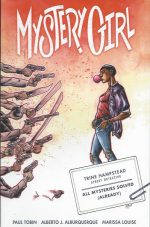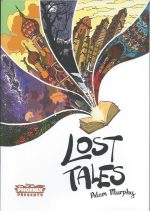
By Gardner Fox & Bob Powell, with James Vance, John Wooley, Mark Schultz & various (Kitchen Sink/Dark Horse Books)
ISBN: 978-1-61655-700-3
Like every art form, comics can be readily divided into masterpieces and populist pap, but that damning assessment necessarily comes with a bunch of exclusions and codicils.
Periodical publications, like all pop songs, movies and the entirety of television’s output (barring schools programming), are designed to sell to masses of consumers. As such the product must reflect the target and society at a specific moment in time and perforce quickly adapt and change with every variation in taste or fashion.
Although very much an artefact of its time I consider “Ever Fallen in Love (With Someone You Shouldn’t’ve)†by The Buzzcocks to be the perfect pop song, but I’m not going to waste time trying to convince anybody of the fact.
For me, and perhaps only for me, it just is.
The situation is most especially true of comics – especially those created before they gained any kind of credibility: primarily deemed by their creators and publishers as a means of parting youngsters from disposable cash. The fact that so many have been found to possess redeeming literary and artistic merit or social worth is post hoc rationalisation.
Those creators striving for better, doing the very best they could because of their inner artistic drives, were being rewarded with just as meagre a financial reward as the shmoes just phoning it in for the paycheck…
That sad state of affairs in periodical publication wasn’t helped by the fact that most editors thought they knew what the readership wanted – safe, prurient gratification – and mostly they were right.
Even so, from such swamps gems occasionally emerged…
The entire genre of “Jungle Girls†is one fraught with perils for modern readers. Barely clad, unattainable, (usually) white paragons of feminine pulchritude lording it over superstitious primitive races is one that is now pretty hard to digest, but frankly so are most of the attitudes of our grandfathers’ time.
However, ways can be found to accommodate such crystallised or outdated attitudes, especially when reading from a suitably detached historical perspective and even more so when the art is crafted by a master storyteller like Bob Powell.
After all, it’s not that big a jump from fictionalised 1950s jungles to the filmic metropolises of today where leather armoured (usually white) Adonises with godlike power paternalistically watch over us, telling we lumpy, dumpy, ethnically mixed losers how to live and be happy…
Sorry, I all comics in all genres from all eras, but sometimes the “guilty pleasure†meter on my conscience just redlines and I can’t stop it. Just remember, it’s not real…
As businessmen, editors and publishers knew what hormonal kids wanted to see and they gave it to them. It’s no different today. Just take a look at any comic-shop shelf or cover listings site and see how many fully-clad, small-breasted females you can spot…
Cave Girl was one of the last entries into the surprisingly long-lived Jungle Queen genre and consequently looks relatively mild in comparison to other titles in regard to suggestive or prurient titillation.
Here the action-adventure side of the equation was always most heavily stressed and readers of the time could see far more salacious material at every movie house if they need to.
End of self-gratifying apologies. Let’s talk about Bob…
Stanley Robert Pawlowski was born in 1916 in Buffalo, New York, and studied at the Pratt Institute in Manhattan before joining one of the earliest comics-packaging outfits: the Eisner-Iger Shop.
He was a solid and dependable staple of American comicbook’s Golden Age, illustrating a variety of key features. He drew original Jungle Queen Sheena in Jumbo Comics plus other Jungle Girl features and Spirit of ’76 for Harvey’s Pocket Comics.
He handled assorted material for Timely titles such as Captain America in All-Winners Comics, Tough Kid Comics plus such genre material as Gale Allen and the Women’s Space Battalion for anthologies like Planet Comics, Mystery Men Comics and Wonder Comics.
Recently he was revealed to have co-scripted/created Blackhawk as well as drawing Loops and Banks in Military Comics as well as so many more now near-forgotten strips: all under a variety of English-sounding pseudonyms, since the tone of the times was rather unforgiving for creative people of minority origins.
Eventually the artist settled on S. Bob Powell and had his name legally changed…
Probably his most well-remembered and highly regarded tour of duty was on Mr. Mystic in Will Eisner’s Spirit Section newspaper insert. After serving in WWII, Bob came home and quit to set up his own studio. Eisner never forgave him.
Powell – with his assistants Howard Nostrand, Martin Epp and George Siefringer – soon established a solid reputation for quality, versatility and reliability: working for Fawcett (Vic Torry & His Flying Saucer, Hot Rod Comics, Lash Larue), Harvey Comics (Man in Black, Adventures in 3-D and True 3-D) and on Street and Smith’s Shadow Comics.
He was particularly prolific in many titles for Magazine Enterprises (ME), including TV tie-in Bobby Benson’s B-Bar-B Riders, Red Hawk in Straight Arrow, Jet Powers and the short but bombastic run of quasi-superhero Strong Man.
Powell easily turned his hand to a vast range of War, Western, Science Fiction, Crime, Comedy and Horror material: consequently generating as a by-product some of the best and most glamorous “Good Girl art†of the era, both in comics and in premiums/strip packages for business.
In the 1960s he pencilled the infamous Mars Attacks cards, illustrated Bessie Little’s Teena-a-Go-Go and the Bat Masterson strip for the newspapers and ended his days drawing Daredevil, the Human Torch and Giant-Man for Marvel.
This captivating hardback compilation gathers all the Cave Girl appearances – written by ubiquitous jobbing scripter Gardner Fox – from numerous ME publications. The company employed a truly Byzantine method of numbering their comicbooks so I’ll cite Thun’da #2-6 (1953), Cave Girl #4 (1953-1954) and Africa, Thrilling Land of Mystery #1 (1955) simply for the sake of brevity and completeness, knowing that it makes no real difference to your enjoyment of what’s to come.
This splendid tome includes a Biography of Bob, an incisive Introduction from Mark Schultz and an erudite essay – ‘King of the Jungle Queens’– by James Vance and John Wooley, diligently examining the origins of the genre (courtesy of the works of Edgar Rice Burroughs, William Henry Hudson’s novel Green Mansions and a slew of B-movies); its development in publishing; the effect of the phenomenon and Powell’s overall contributions to comics in a far more even-handed and informed way than I can manage…
That done it’s time to head to an Africa that never existed for action and adventure beyond compare. Cave Girl started as a back-up strip in Thun’da #2; a primeval barbarian saga set in an antediluvian region of the Dark Continent where dinosaurs still lived.
In ‘The Ape God of Kor’ the mighty primitive encounters a blonde stranger who can speak to birds and beasts, and helps her escape the unwanted attentions of a bestial tyrant. When that’s not enough to deter the monstrous suitor, Thun’da and Cave Girl have no choice but to topple his empire…
In #3 the wild woman met ‘The Man Who Served Death!‘ – a criminal from the outer world whose hunger for gold and savage brutality necessitated his urgent removal from the land of the living. Cave Girl’s beloved animal allies were being wantonly slaughtered to appease ‘The Shadow God of Korchak!’, forcing the gorgeous guardian of the green to topple the lost kingdom’s debauched queen, after which the tireless champion tackled a trio of sadistic killers from the civilised world in ‘Death Comes Three Ways!’
A rather demeaning comedy sidekick debuted in ‘The Little Man Who Was All There!’ from Thun’da #6 as pompous pigmy bumbler Bobo attached himself to Cave Girl as her protector…
From there the forest monarch leaped into her own title, beginning with Cave Girl #11. ‘The Pool of Life!’ delved back in time to when a scientific expedition was wiped out, leaving little blonde toddler Carol Mantomer to fend for herself. Happily, the child was adopted by Kattu the wolf and grew tall and strong and mighty…
The obligatory origin dispensed with, the story proceeds to reveal how two white explorers broach the lost valley in time to reap their deserved fate after finding a little lake with mystic properties…
Tables are turned when explorer Luke Hardin deduces Cave Girl’s true identity and convinces the wild thing to come with him to Nairobi to claim her inheritance. Already appalled by the gadgets and morass of humanity in ‘The City of Terror!’, Carol’s decision to leave is cemented by her only living relative’s attempts to murder her for her inheritance…
En route home, her wild beauty arouses the desires of millionaire hunter Alan Brandon, but his forceful pursuit and attempted abduction soon teaches him he has a ‘Tiger by the Tail!’
Her trek done, Cave Girl traverses high mountains and finds Alan and Luke have been captured by beast-like primitives and must face the ‘Spears of the Snowmen’ to save them both…
Even the usually astoundingly high-quality scripting of veteran Gardner Fox couldn’t do much with the formulaic strictures of the sub-genre but he always tried his best, as in Cave Girl #12 which opened with ‘The Devil Boat!’ – a submarine disgorging devious crooks in death-masks intent on plundering the archaeological treasures found by Luke… Then when an explorer steals a sacred cache of rubies he finds that even Cave Girl can’t prevent him becoming ‘Prey of the Headhunters!’
Fantastic fantasy replaces crass commercial concerns as ‘The Amazon Assassins’ ravage villages under Cave Girl’s protection, seeking to expand their empire. The Women Warriors have no conception of the hornet’s nest they are stirring up…
Cave Girl #13 took its lead tale from newspaper headlines as the jungle defender clashed with ‘The Mau Mau Killers!’ killing innocents and destabilising the region, after which ‘Altar of the Axe’ features the return of the all-conquering Amazons who believe they can counter their arch-enemy’s prowess with a battalion of war elephants.
Their grievous error then seamlessly segues into a battle with escaped convict Buck Maldin. ‘The Jungle Badman’ is beaten by Cave Girl but it’s greedy buffoon Bobo who quickly regrets claiming the reward.
Powell reached a creative zenith with the illustrations for Cave Girl #14 (1954), his solid linework and enticing composition augmented by a burst of purely decorative design which made ‘The Man Who Conquered Death’ a dramatic tour de force.
When a series of murders and resurrections lead Cave Girl to a mad scientist who has found a time machine, she is transformed into an aged crone but still possesses the force of will to beat the deranged meddler…
A tad more prosaic, ‘The Shining Gods’ finds a rejuvenated Cave Girl and Luke stalking thieves stealing tribal relics only to uncover a Soviet plot to secure Africa’s radium, after which the queen of the jungle is “saved†by well-intentioned rich woman Leona Carter and brought back to civilisation.
Happily, after poor Carol endures a catalogue of modern mishaps which equate to ‘Terror in the Town’, Cave Girl is allowed to return to her true home…
The official series ended there, but ME had one last issue ready to print and deftly shifted emphasis by re-badging the package as Africa, Thrilling Land of Mystery #1. It appeared in 1955, sporting a Comics Code Authority symbol. Inside however, it was still formulaic but beautifully illustrated Cave Girl who exposed a conniving witch doctor using ‘The Volcano Fury’ to fleece natives, restoring ‘The Lost Juju’ of the devout Wamboolis whilst stopping a murderous explorer stealing a million dollar gem and crushing a potential uprising by taking a fateful ride on ‘The Doom Boat’…
And then she was gone.
Like the society it protected from subversion and corruption, the strictures of the Comics Code frowned on females disporting themselves freely or appearing able to cope without a man, and the next half-decade was one where women were either submissive, domesticated, silly objects of amusement or just plain marital manhunters. It would be the 1970s before strong, truly independent female characters reappeared in comicbooks…
Whatever your political leanings or social condition, Cave Girl – taken strictly on her own merits – is one of the mostly beautifully rendered characters in pictorial fiction and a tribute to the talents of Bob Powell and his team. If you love perfect comic storytelling, of its time, but transcending fashion or trendiness, this is a treasure just waiting to be rediscovered.
Bob Powell’s Complete Cave Girl compilation © 2014 Kitchen, Lind and Associates LLC. Cave Girl is a trademark of AC Comics, successors in interest to Magazine Enterprises and is used here with permission of AC Comics. Introduction © 2014 Mark Schultz. “King of the Jungle Queens†essay © 2014 James Vance and John Wooley. All rights reserved.











